"The climate and environmental changes being predicted by experts will alter the risk to Europe from vector-borne diseases" Zsuzsanna Jakab, head of ECDC, the European Centre for Disease Prevention and Control.
More disease outbreaks in the future
Europe could face an increase in outbreaks of vector-borne diseases. These diseases are transmitted by arthropods such as ticks (e.g. tick-borne encephalitis (TBE), Lyme disease), mosquitoes (e.g. Chikungunya fever, Dengue fever, malaria, Rift Valley fever), or sandflies (e.g. visceral leishmaniasis). Climatic changes, such as hotter and longer summers, warmer winters, and/or increased annual rainfalls could enable these cold-blooded organisms to shift their habitats, potentially introducing diseases to places where they have not been seen before or reintroducing them to places where they were previously eradicated.
In addition to climate change, the risk of vector-borne diseases is growing due to globalisation and the increased travel, migration and trade that it brings.
Finally, changes in land and water use patterns will remain major factors in the spread of infectious diseases. The emergence of Lyme disease has been linked to reforestation and increases in the deer tick population, which acts as a vector.
An example of the increased threat of disease outbreak linked to climate change was seen in 2007, when a traveller who had been infected in India with chikungunya fever was bitten in northern Italy by Aedes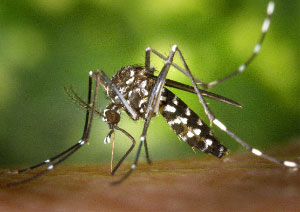 albopictus or Asian tiger mosquito, a type of mosquito that can carry the disease and that recently arrived in Europe.
albopictus or Asian tiger mosquito, a type of mosquito that can carry the disease and that recently arrived in Europe.
Nearly 250 people subsequently came down with the illness in what some experts said could be the first such outbreak outside the tropics.
Chikungunya fever is a viral illness that typically lasts from five to seven days and frequently causes severe and often incapacitating joint pain which sometimes persists for much longer periods. It is rarely life-threatening but experts are nervous because the Asian tiger mosquito might be capable of spreading more dangerous diseases like dengue fever and yellow fever.
Asian tiger mosquito - Source
Vector-borne diseases and the possible effect of climate change
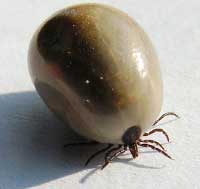 Tick borne encephalitis (TBE) and Lyme disease
Tick borne encephalitis (TBE) and Lyme disease
These diseases are already present in Europe and have shown significant recent increases in incidence.
TBE infects the central nervous system and is spread by Ixodes ricinus ticks. TBE is endemic in southern Scandinavia and central and Eastern Europe. The number of infections with TBE in some areas has increased by nearly 400% over the past 30 years, making TBE a major public health challenge.
Climate change may extend both the length of the transmission season and facilitate spread of tick borne diseases to higher latitudes and altitudes.
The increased infections may partly also be due to increased recreation in forested areas, as warmer weather in spring and autumn permits more outdoor activities.
Climate change
Over the past 150 years, mean temperature has increased by almost 0.8 ºC globally and by about 1 ºC in Europe. According to the 4th IPCC report (2007), eleven of the last twelve years (1995–2006) rank among the 12 warmest years in the instrumental record of global surface temperature (since 1850).
In Europe the largest temperature increases are in southern Europe and the Arctic region. Precipitation decreases in southern Europe and increases in the north/north-west.
A change in the distribution of important vector-borne diseases may be among the first signs of the effect of climate change on human health.
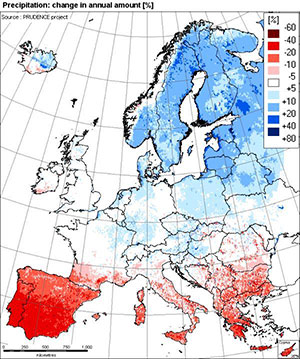
Relative change in mean annual precipitation between control
period 1961-1990 and 2071-2100, under the IPCC SRES scenario A2
Data from EC-funded project Prudence, map elaboration by EC JRC/IES
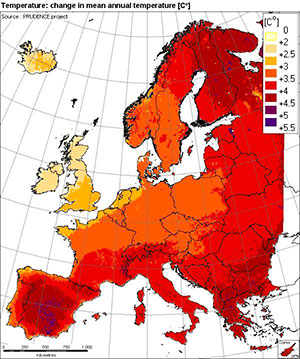
Absolute change in mean annual temperature between control
period 1961-1990 and 2071-2100, under the IPCC SRES scenario A2
Data from EC-funded project Prudence, map elaboration by EC JRC/IES
Hantavirus
Hantavirusses cause widespread but under-reported diseases within Europe, with strong links with habitat and landscape structures. Hantavirus causes an infection that can cause haemorrhagic fever with renal syndrome (HFRS). It is transmitted from rodent to rodent through body fluids and excreta and only occasionally are humans infected. Theory suggests that changing climates have influenced rodents' migration patterns and the physiological viral adaptation processes
Leishmaniasis
Visceral leishmaniasis is transmitted by sandflies and dogs are the main carriers of the parasites. It is endemic in countries bordering the Mediterranean and has become an important co-infection with HIV. 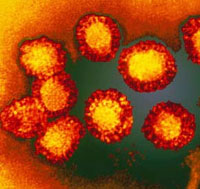 There are two main forms of leishmaniasis. Cutaneous leishmaniasis causes lesions to appear on the skin. Visceral leishmaniasis disease attacks the internal organs of the body, and it is fatal without treatment. With climate warming there is a risk of visceral leishmaniasis extending further North in Europe.
There are two main forms of leishmaniasis. Cutaneous leishmaniasis causes lesions to appear on the skin. Visceral leishmaniasis disease attacks the internal organs of the body, and it is fatal without treatment. With climate warming there is a risk of visceral leishmaniasis extending further North in Europe.
West Nile Virus
West Nile virus is a mosquito-borne disease that can cause encephalitis, a brain inflammation. Periodic and occasionally severe local outbreaks occur on the Eastern fringes of Europe, as the result of a combination of factors including favourable weather conditions, abundant mosquito vectors and infected migrating birds.
Source
Malaria
Malaria is a potentially fatal blood disease caused by a parasite that is transmitted to human and animal hosts by the Anopheles mosquito. The human parasite, Plasmodium falciparum, is dangerous not only be cause it digests the red blood cell's hemoglobin, but also because it changes the adhesive properties of the cell it inhabits. This change in turn causes the cell to stick to the walls of blood vessels. It becomes especially dangerous when the infected blood cells stick to the capillaries in the brain, obstructing blood flow, a condition called cerebral malaria.
Malaria causes over 2.7 million deaths per year. It is currently endemic on Europe’s Southern and Eastern fringes, with the potential for re-emergence following climate changes which will become more favourable for the different mosquito species that are present in the region, as well as for the malaria parasites.
With a rise of temperatures in Europe, there is concern about the possible recrudescence of malaria transmission. Such a recrudescence has already been seen in Eastern Europe. In light of the constant introduction of malaria cases from endemic countries, local transmission could reoccur in Western Europe, should the densities of vector populations increase. For example, in the United Kingdom it was estimated that, with temperature increases, the risk of local malaria transmission could increase by 8–15% by 2050.
Nevertheless, there is agreement that the risk of transmission of malaria related to localized climate change in Western Europe is very small. Risks are greater in the countries where importation of malaria coincides with socio-economic degradation, the disintegration of health and social services, uncontrolled cross-border migration and lack of environmental management for mosquito control.
Sources
EDEN (Emerging Diseases in a changing European eNvironment)
Emerging Infectious Diseases - Center for Disease Control and Prevention
Emerging Pests and Vector-borne Diseases in Europe - Center for Disease Control and Prevention
European Centre for Disease Prevention and Control
European Environment Agency
Modern Menace: Emerging & Re-Emerging Infectious Diseases - Health Media
More disease outbreaks in Europe with climate change - France 24
Protecting Health in Europe from climate change - World Health Organization Europe
The Global Infectious Disease Threat and Its Implications for the US - US National Intelligence Council
The Vector-borne Human Infections of Europe - World Health Organization Europe
This page was written in 2009, as additional information to the poster series "10 years of Imaging the Earth"